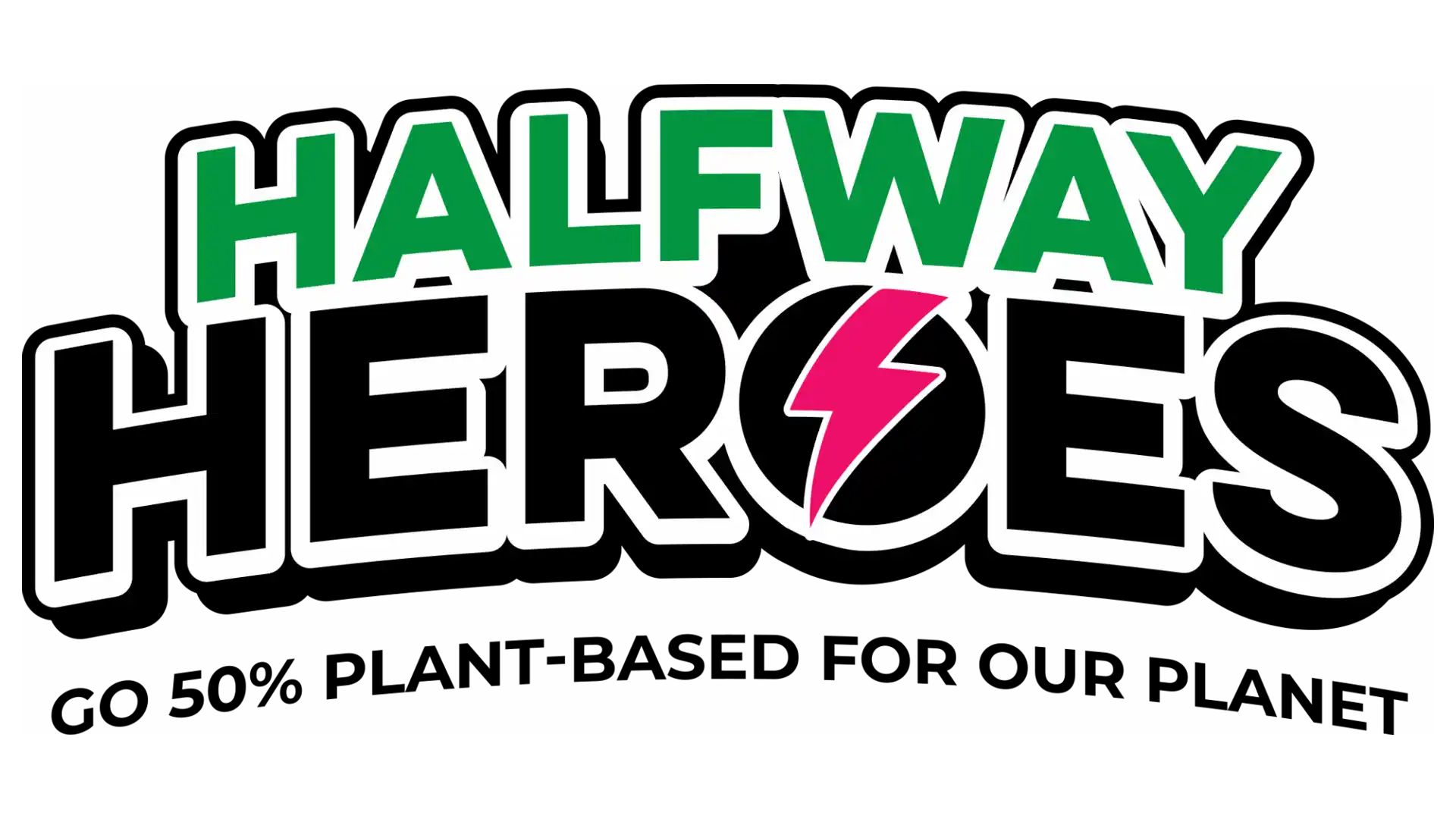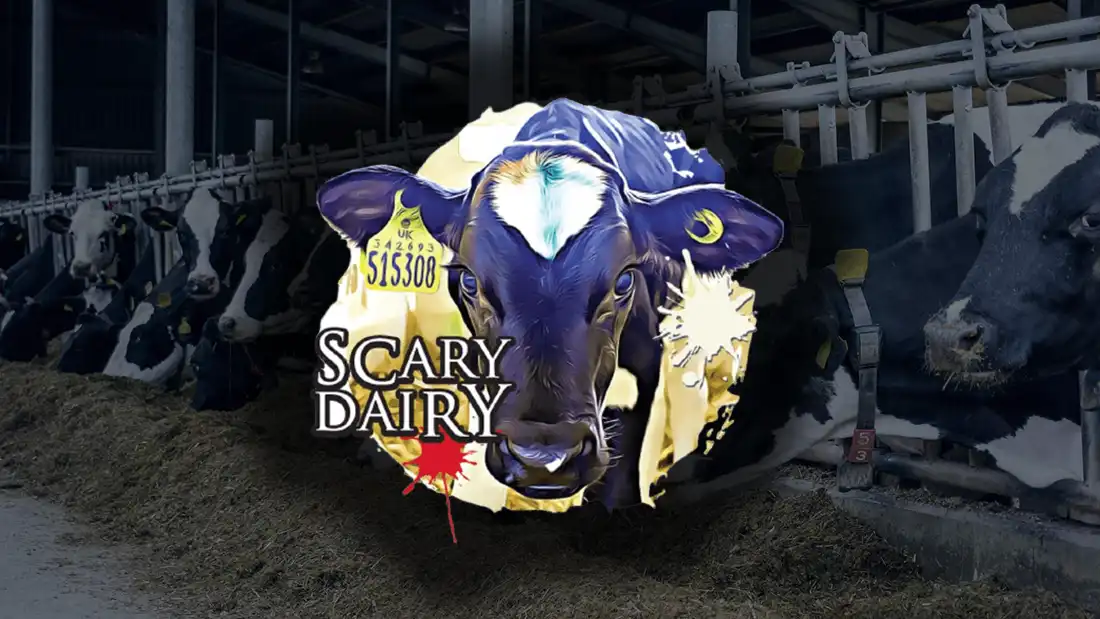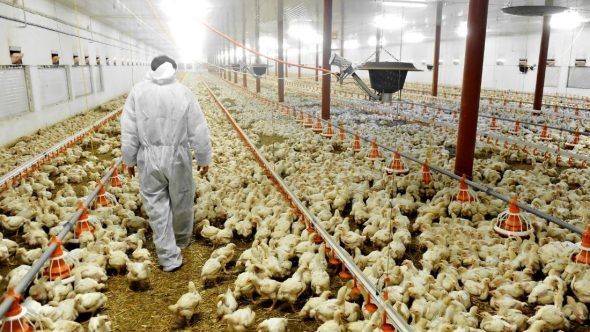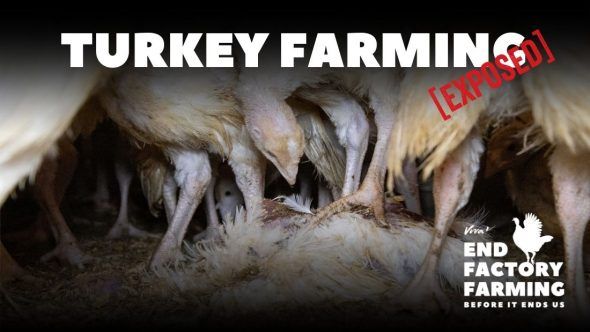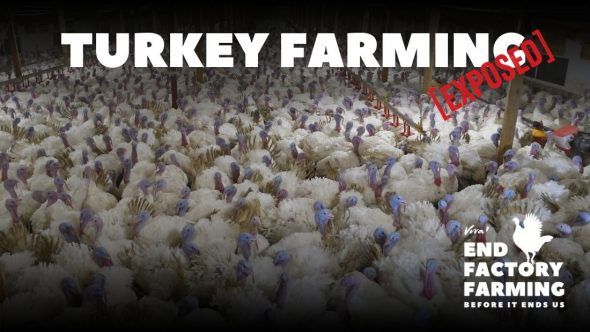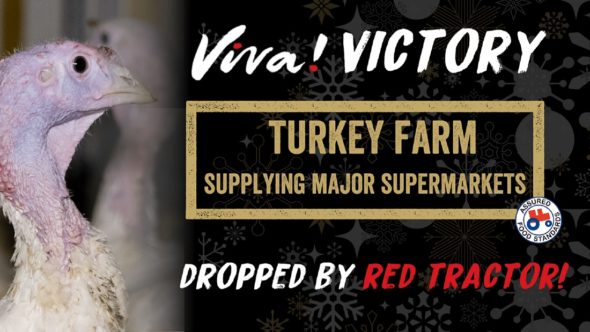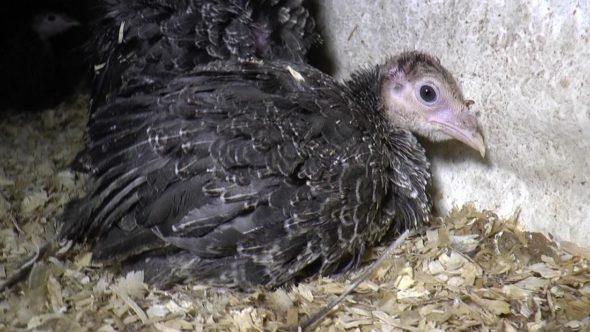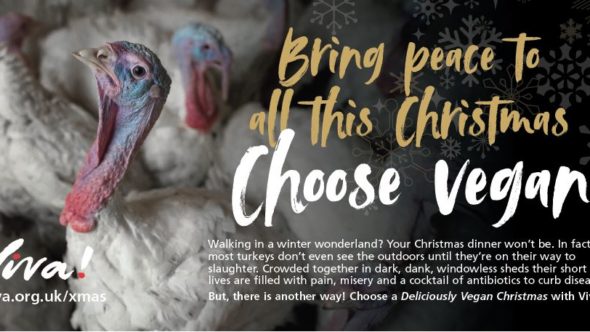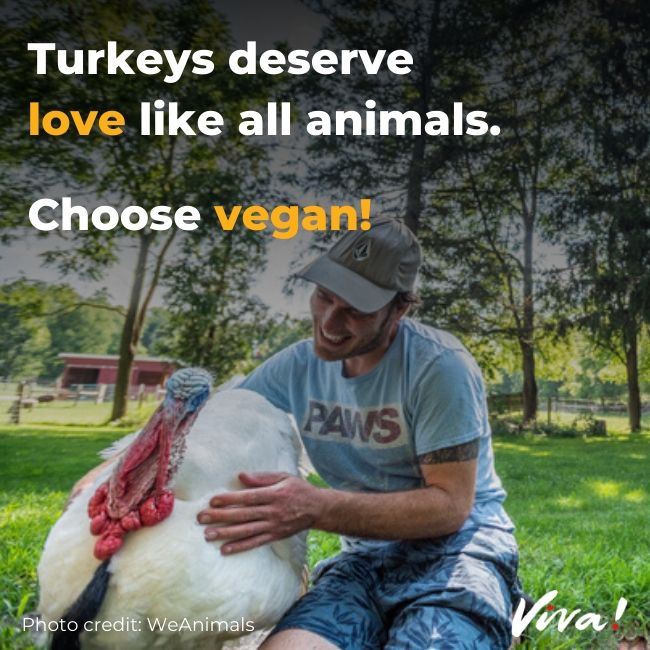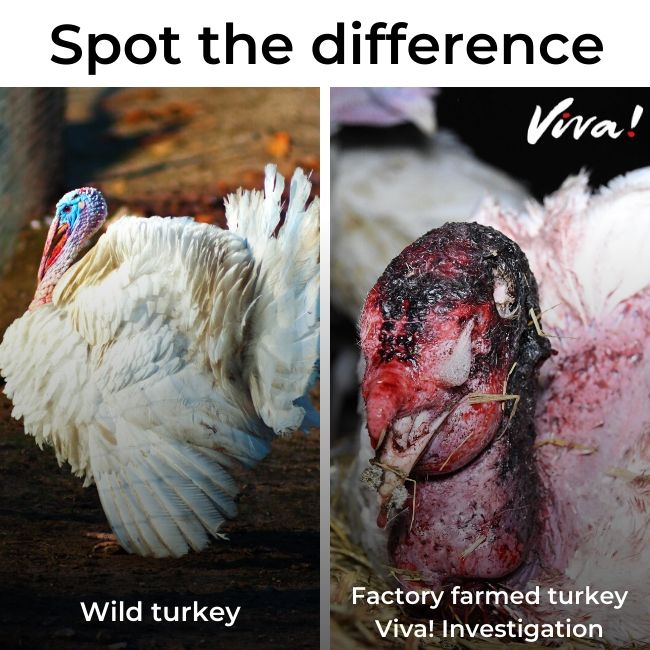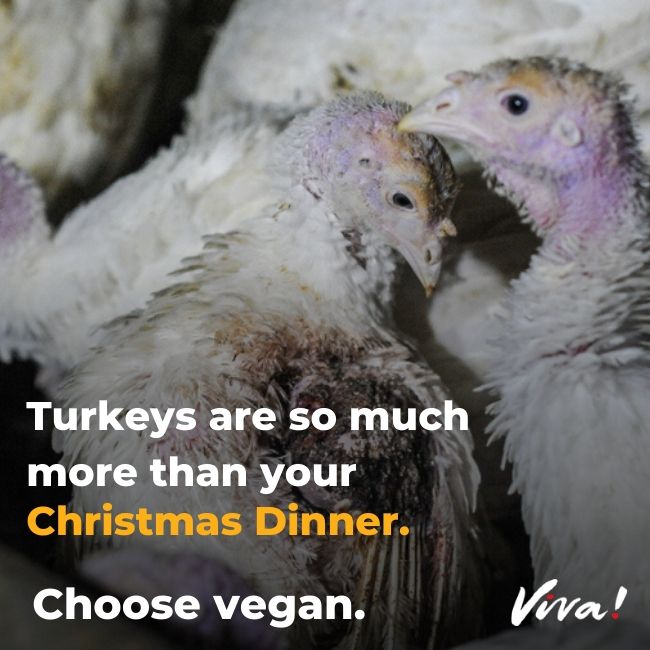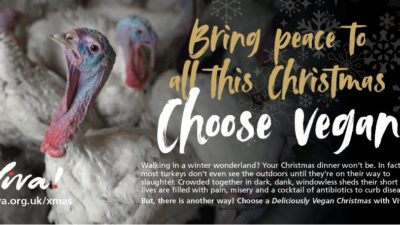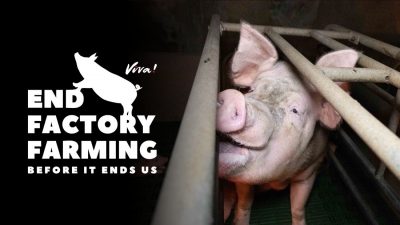How Turkeys Are Farmed and Killed

Fun Facts about Turkeys
- Turkeys are very playful. If you toss an apple to a group of turkeys, they will play with it like a football.8Hougham, A., 2003. ‘Turkeys: Much Smarter Than You Think’. Upc-online.org. Available at https://www.upc-online.org/turkeys/120403notdumb.htm [Accessed 6 April 2020].
- They are very affectionate and establish lasting social bonds with each other; rather similar to dogs.9Goldman, J., 2013. ‘Nothing To Gobble At: Social Cognition In Turkeys’. Scientific American Blog Network. Available at https://blogs.scientificamerican.com/thoughtful-animal/nothing-to-gobble-at-social-cognition-in-turkeys [Accessed 7 April 2020].
- Some turkeys run to their human companions for cuddles. They love to be stroked and petted. They will remember your face and if they like you, they will come up to you to greet you.
- Turkeys have a keen sense of hearing even though they have no ears! They have a 300 degree field of full-colour vision and can see movement almost a hundred metres away.10Hale, E.B., Schleidt, W.M. and Schein, M.W., 1969. The behavior of turkeys. In The behaviour of domestic animals (pp. 554-592). Baillière: Tindall & Cassell.
- Turkeys don’t just say ‘gobble, gobble’– they have over 30 distinct vocalisations, including ‘yelps,’ ‘purrs,’ and ‘kee-kees.’ Turkeys can recognise each other by their unique voices!11Hickoff, S., 2009. Turkey Calls And Calling. Stackpole Books.
- Turkeys love music and will cluck along with songs.12William, E., 2017. ‘Experience: I’m a Turkey Whisperer’. The Guardian 22 December. Available at https://www.theguardian.com/lifeandstyle/2017/dec/22/i-am-a-turkey-whisperer-experience [Accessed 6 April 2020].
- Turkeys’ flashy snoods tell other turkeys, particularly females, how they are feeling!13Smith, A. F., 2006. The Turkey: An American Story. US: University of Illinois Press. When a male turkey is relaxed, his snood is pale and short, but when he begins strutting in courtship display, his snood engorges with blood, becomes redder and elongates several centimetres.
- Turkeys are very intelligent, are really good at geography and can learn the details of very large areas, which is especially useful for finding food. Wild turkeys return to exact locations an entire year after feeding there.14McWilliams, J., 2010. ‘Consider The Turkey’. The Atlantic. Available at https://www.theatlantic.com/health/archive/2010/11/consider-the-turkey/66967 [Accessed 7 April 2020].
Turkey Intelligence
It’s a common misconception that turkeys are dumb animals. One of the reasons why people think turkeys are not very smart is because of the story of how turkeys can drown in a rainstorm by looking up in the sky until their nostrils are filled with water.
Tom Savage, an American poultry scientist at Oregon State University, has studied turkeys for 30 years and argues that in fact, turkeys are very smart animals indeed. His research, at the beginning of the 1990s, found that turkeys’ behaviour of staring up at the sky is a genetically-caused nervous disorder called ‘tetanic torticollar spasm’.1Savage, T., 2009. ‘OSU Animal Scientist Debunks Dumb Turkey Myth’. Life at OSU. Available at https://today.oregonstate.edu/archives/2003/nov/osu-animal-scientist-debunks-dumb-turkey-myth [Accessed 8 April 2020]. So if you see a turkey staring into the sky for a few minutes, it is likely that he or she is experiencing one of those episodes. After a few minutes, the turkey will go back to what they were doing before.
Another argument for turkeys’ intelligence is their complex vocalisations. They have over 30 different vocalisations. Their calls have different functions, for example keeping the flock together, telling other turkeys about especially good food and warning of danger.
When one bird is trapped and is calling out to the others, his or her peck members would run over to see what’s going on.2Hickoff, S., 2009. Turkey Calls And Calling. Mechanicsburg: Stackpole Books The well known ‘gobble’ is used by males to attract females and repel other males during the mating season. When turkeys are roosting in the trees at night, they have a special call to communicate with those who are roosting nearby.
Young turkeys use a high pitched ’kee-kee’ when they have lost the rest of the group and want to regroup.3Nwtf.org. 2020. ‘What Does A Turkey Say?’ NWTF. Available at https://www.nwtf.org/hunt/article/wild-turkey-calls-defined [Accessed 8 April 2020]. Hunters frequently use turkey-like calls to fool turkeys and locate them in woodlands.
On the social cognition front, turkeys are really quite clever.4Goldman, J., 2013. ‘Nothing To Gobble At: Social Cognition In Turkeys’. Scientific American Blog Network. Available at https://blogs.scientificamerican.com/thoughtful-animal/nothing-to-gobble-at-social-cognition-in-turkeys [Accessed 7 April 2020]. At six months olds, the male poults (young) of the flock separate from their mothers and sisters and form life-lasting sibling groups. Living in groups is much safer than living on their own when it comes to protection from predators.
Wild turkeys, as well as domesticated ones, can distinguish between in-group and out-group members.5Buchwalder, T. and Huber-Eicher, B., 2003. ‘Effect of increased floor space on aggressive behaviour in male turkeys (Meleagris gallopavo)’. Applied Animal Behaviour Science, 89(3-4), pp.207-214. More than that, if one turkey is removed from his flock, he will squawk in protest until reunited with the flock.4Goldman, J., 2013. ‘Nothing To Gobble At: Social Cognition In Turkeys’. Scientific American Blog Network. Available at https://blogs.scientificamerican.com/thoughtful-animal/nothing-to-gobble-at-social-cognition-in-turkeys [Accessed 7 April 2020].
Domesticated turkeys recognise their human carer and often greet them with excitement and joy.6Hutto, J., 2006. Illumination in the Flatwoods: A Season with the Wild Turkey. Lander: Lyons Press In sanctuaries, turkeys have been seen to follow their human carer around and show enjoyment of being stroked with satisfied purring. When Viva!’s founder, Juliet, rescued a turkey (won in a church raffle by a supporter who asked for the bird to be delivered alive!) – she describes how Bertie was “the most affectionate friend, following me everywhere and shimmying her feathers with delight at shoulder massages. Her range of sounds when talking with me was astonishing and fascinating.”
Turkeys are very intelligent birds with complex social systems. Factory farming denies them most of their natural behaviour which leads to high stress levels and suffering.
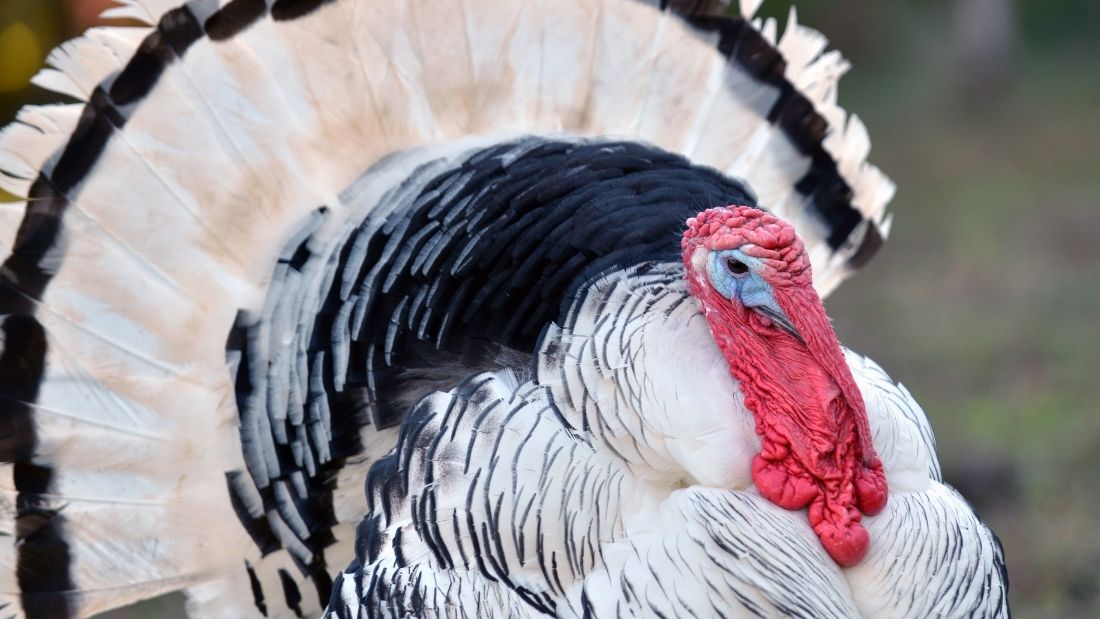
Turkeys are striking and handsome, graceful and intelligent. Male adult turkeys are called toms or gobblers, terms that are interchangeable. Female adult turkeys are referred to as hens and their young are called poults. A young male turkey is called jake and a young female turkey is called jenny (Glossary of Poultry Terms | Animal & Food Sciences, 2020).
Origin and History
Wild turkeys (Meleagris gallopavo) belong to the Galliformes family, Phansianidae, along with chickens and pheasants. There are six different recognised subspecies of wild turkey, which includes the familiar domesticated turkey (Meleagris gallopavo gallopavo).
Today, we distinguish between two extant (living) turkey species. Meleagris gallopavo turkeys are the wild variety of North America’s turkey who originated from Mexico. It is from these that the domesticated turkey descended. They still live in North and Central America and Benjamin Franklin wanted the wild turkey to be the national bird of the US instead of the Bald Eagle (Smith, 2006). Meleagris ocellate or ocellated turkeys originally came from Guatemala, Belize and Mexico’s Yucatán peninsula (Smith, 2006). They have small bodies with short legs and are bronze-green or copper coloured
By the beginning of the 20th century, the population of wild turkeys had fallen due to excessive hunting and loss of their woodland habitat. Thanks to reintroduction programmes started in the 1940s, turkey populations have been increasing and they have extended their range as far as New Zealand, Hawaii and Europe.
Habitat
Turkeys’ preferred habitat is forest floors in open woodlands where they can forage for food, however they do also live in grassland and swamps.1Cornell University, 2019. ‘Wild Turkey Overview, All About Birds, Cornell Lab Of Ornithology’. Allaboutbirds.org. Available at https://www.allaboutbirds.org/guide/Wild_Turkey/overview [Accessed 16 April 2020]. Domestic turkeys cannot fly due to excessive weight from selective breeding which has produced extra-large breasts… but wild turkeys can indeed take to the skies!
They are agile, fast fliers and can reach speeds of 55 mph – and they can also run at about 25 miles per hour!2Britt, R., 2008. ‘5 Surprising Turkey Facts’. Available at: https://www.livescience.com/7630-5-surprising-turkey-facts.html [Accessed 20 April]. Wild turkeys need to fly as they roost in trees at night. In straight flight, they usually fly close to the ground which makes them an easy target and this, sadly, has contributed to them being ruthlessly hunted. At twilight, most turkeys will head for the trees and roost, up to 16 meters off the ground in numbers as protection against predators.
Social Groups
Turkeys live in flocks, with males and females typically forming separate flocks of up to 30 birds in summer.1Cornell University, 2019. ‘Wild Turkey Overview, All About Birds, Cornell Lab Of Ornithology’. Allaboutbirds.org. Available at https://www.allaboutbirds.org/guide/Wild_Turkey/overview [Accessed 16 April 2020]. Winter groups are often bigger and can exceed 200 birds. Each flock has a pecking order, with females having a stable hierarchy while males have a constantly changing hierarchy. There are also mother and poults flocks, with the hen being very protective of her young.
In early spring, male turkeys perform their courtship display in wood clearings to impress the females. They call them with their unique gobbling call, puffing up their feathers, displaying a vertical fan by flaring their tail feathers and slowly strutting along.
Hens build their nests on the ground and lay four to 17 eggs, which have an incubation period of 25-31 days.1Cornell University, 2019. ‘Wild Turkey Overview, All About Birds, Cornell Lab Of Ornithology’. Allaboutbirds.org. Available at https://www.allaboutbirds.org/guide/Wild_Turkey/overview [Accessed 16 April 2020]. The female regularly rotates the eggs in her nest until day 25 and from then on, the poults inside the eggs can manage to do the rotating themselves.3Hutto, J. and Guiberson, B.Z., 2017. ‘When I Was a Turkey: Based on the Emmy Award-Winning PBS Documentary My Life as a Turkey’. Henry Holt Books For Young Readers. US: Henry Holt and Co. When they start to hatch, the birds inside the egg start to peck the first small hole in the shell.3Hutto, J. and Guiberson, B.Z., 2017. ‘When I Was a Turkey: Based on the Emmy Award-Winning PBS Documentary My Life as a Turkey’. Henry Holt Books For Young Readers. US: Henry Holt and Co.
Poults have a projection on their beak called an ’egg tooth’ for the first days, solely for the purpose of pecking the first tiny hole into their egg. They even have a special head muscle which will help them to crack open the egg shell from inside.3Hutto, J. and Guiberson, B.Z., 2017. ‘When I Was a Turkey: Based on the Emmy Award-Winning PBS Documentary My Life as a Turkey’. Henry Holt Books For Young Readers. US: Henry Holt and Co.
After hatching, poults follow their mother for a few days, who will feed them until they learn to forage themselves. At night, mother turkeys stay with their poults at ground-level to keep them safe and warm until they learn to fly and roost up in the trees. Male turkeys are not involved in the taking care of chicks.
Natural Diet
Turkeys are omnivores and eat plants, fruits, seeds, worms and insects. Healthy turkeys have enough body fat to survive a week or longer without leaving their roost trees.
Life Expectancy
Turkeys can live up to 13 years, however few live that long in the wild because of predation. Average lifespan in the wild is three to four years.4McRoberts, J. T., M. C. Wallace, and S. W. Eaton (2020). Wild Turkey (Meleagris gallopavo), version 1.0. In Birds of the World (A. F. Poole, Editor). Cornell Lab of Ornithology, Ithaca, NY, USA.
Predators
Predators of wild turkeys are people, golden eagles, coyotes, racoons, bobcats, mountain lions and great horned owls1Cornell University, 2019. ‘Wild Turkey Overview, All About Birds, Cornell Lab Of Ornithology’. Allaboutbirds.org. Available at https://www.allaboutbirds.org/guide/Wild_Turkey/overview [Accessed 16 April 2020]. – but mostly people! When nesting on the ground, turkey eggs are also commonly taken by opossums, striped skunks, rat snakes, gray foxes, bull snakes, birds and rodents.
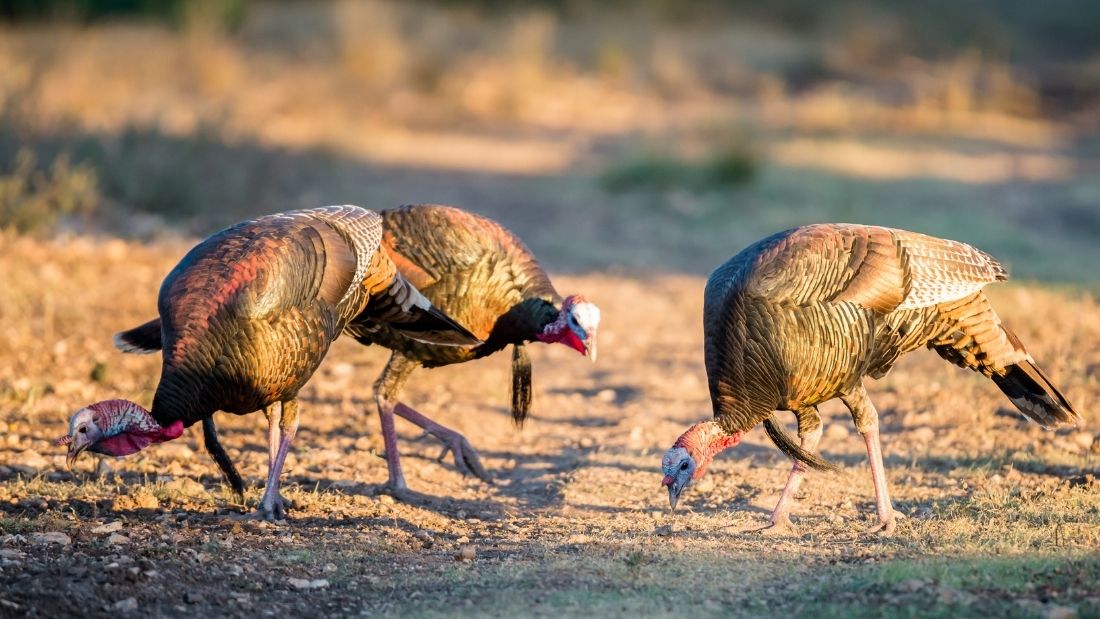
About 14 million turkeys are killed a year in the UK for food. There are three main breeds of turkeys who are used for their meat: white, black and bronze. White turkeys have a wide breast and short legs. Bronze turkeys are distinguished by their special colouring – a shimmering green-bronze.
Systems of turkey rearing
1. Intensive Units
This is the most common system, where up to 25,000 turkeys are kept in one shed,1UFAW, 2011. Management and welfare of farm animals. Wiley-Blackwell. and is responsible for 90 per cent of turkey production in the UK.2McKenzie, D., 2019. Sustainable Food Trust. Available at https://sustainablefoodtrust.org/articles/what-makes-a-sustainable-christmas-dinner-the-ecological-footprint-of-festive-feasting [Accessed 20 April 2020].
Birds are crowded together in much the same way as broiler chickens on a litter-covered floor. Litter can be comprised of many different dry materials such as chopped straw and saw dust and it remains unchanged for the life of the birds.1UFAW, 2011. Management and welfare of farm animals. Wiley-Blackwell. Faeces accumulate in the litter, making it increasingly soggy as the birds’ age and ammonia builds up. As a result, turkeys can develop ulcerated feet and painful burns on their legs and breasts as they spend their short lives standing or crouching on dirty, wet litter.
Birds can become stressed and frustrated by these living conditions and resort to feather pecking and, in some cases, cannibalism and so low lighting is used to discourage aggression. It can also cause reduced activity levels in birds, resulting in growth abnormalities, and affect their eyes and legs.3RSPCA, 2020. Turkey Welfare – Housing, Selective Breeding, Beak Trimming & Lighting. Available at https://www.rspca.org.uk/adviceandwelfare/farm/turkeys/keyissues [Accessed 17 April 2020].
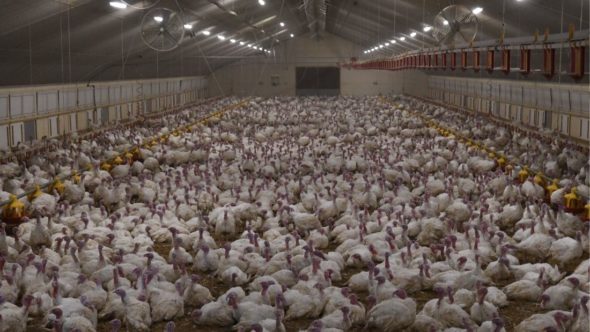
2. Pole barns
These allow daylight and some ventilation as the upper parts of the shed walls are open. Conditions are still overcrowded with little opportunity to express natural behaviour and the stress causes fighting with birds attacking each other’s eyes and toes.
3. Free range
On free range farms, turkeys may be afforded 10 square metres per bird, or 1,000 birds per hectare4Defra, 2020. ‘Poultry: Welfare Recommendations’. GOV.UK. Available at https://www.gov.uk/government/publications/poultry-on-farm-welfare/poultry-welfare-recommendations [Accessed 21 April 2020]. of outside space but they will also spend a considerable amount of their lives indoors in sheds. In winter, it will be the most of the time. They may be subjected to the same mutilations as more intensively-reared birds.
Those labelled ‘organic’ are not given antibiotics as a preventive measure against disease but only when they fall ill.5SOIL ASSOCIATION, 2020. Organic Poultry, Chickens & Eggs | Soil Association. Available at https://www.soilassociation.org/organic-living/why-organic/better-for-animals/poultry-chickens [Accessed 20 April 2020]. Both intensively reared and free-range turkeys are susceptible to a range of diseases – including bird flu. Indoor housing may be very similar to pole barns but with access to an outside area some of the time.
Life on factory farms
Sheds on intensive turkey farms are massively overcrowded, especially as the birds grow bigger. Turkeys peck at each other’s feathers, toes and eyes when overcrowded and sometimes the entire eye is destroyed by pecking.
Cannibalism can be common and so birds are often kept in low light to discourage cannibalism. Government standards state that birds mustn’t be kept in permanent darkness, so when natural light levels fail to meet the needs of the turkeys artificial lighting is used.4Defra, 2020. ‘Poultry: Welfare Recommendations’. GOV.UK. Available at https://www.gov.uk/government/publications/poultry-on-farm-welfare/poultry-welfare-recommendations [Accessed 21 April 2020].
In the wild, turkeys are not aggressive but on factory farms they are driven to aggression by the conditions in which they are kept.
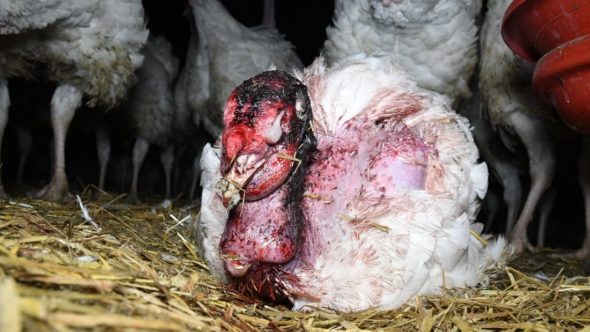
Mutilation
Beak trimming, desnooding (the snood is a fleshy protuberance on the forehead), and toe cutting are all mutilations allowed under government ‘welfare’ recommendations.4Defra, 2020. ‘Poultry: Welfare Recommendations’. GOV.UK. Available at https://www.gov.uk/government/publications/poultry-on-farm-welfare/poultry-welfare-recommendations [Accessed 21 April 2020]. They are done to reduce injuries from severe feather pecking in overcrowded sheds where lack of space and lack of environmental enrichment commonly lead to aggression.
When turkeys are only a few days old, their beaks are trimmed with an infrared light which causes the sharp tip of their beak to blunt.6Farmers Weekly, 2019. ‘What UK farmers can learn from German turkey beak trim ban’. Available at: https://www.fwi.co.uk/livestock/poultry/other-poultry/advice-on-managing-turkeys-without-beak-treatment [Accessed 20 April 2020]. Beak tips are rich in sensory nerve endings, a bit like our finger tips and ‘trimming’ them can lead to both acute and chronic pain and results in some birds having difficulties with eating.
In 2010, the Government dropped its plans to outlaw debeaking the following year. It was again meant to happen in 2016 but was again abandoned despite successful bans in other countries in Europe such as Sweden, Norway and Finland.
Toe removal is performed on male breeding birds to prevent them scratching other birds and so reducing their carcass value. It can result in open wounds, blood loss and pain.
Desnooding is practiced to minimize cannibalism. This is where the long fleshy appendage extending from the front of a turkey’s head over its upper back is removed with an instrument or simple pulled off.
When farmers want to prevent turkeys from flying, the flight feathers of one wing are clipped.
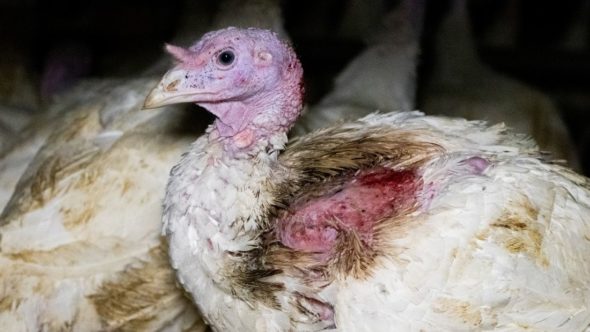
Breeding
Turkeys are bred almost exclusively by artificial insemination (AI).7RSPCA. 2021. Farming Turkeys. Available: https://www.rspca.org.uk/adviceandwelfare/farm/turkeys/farming [Accessed 15 Apr 2021]. Because turkeys have been selectively bred to be monstrously larger than they would be in nature, they are usually “unable to physically complete the mating process”.8Bramwell, R. K. 2021. Artificial Insemination in Turkeys and Chickens. MSD Veterinary Manual. Available: https://www.msdvetmanual.com/poultry/artificial-insemination/artificial-insemination-in-turkeys-and-chickens [Accessed 15 Apr 2021]. Their breasts are now so over-sized that they get in the way of the male turkey mounting the female, which results in very low fertility rates. Therefore, turkey breeders literally have to take matters into their own hands.
Housing turkeys for breeding
Because “natural” breeding only tends to happen on small-scale heritage turkey farms, most hens and toms on intensive farms are kept in separate barns,9Christen, C. 2020. Turkey Farming: How Intensive Breeding Is Transforming the Industry. Sentient Media. Available: https://sentientmedia.org/turkey-farming/ [Accessed 15 Apr 2021]. never coming into contact with the opposite sex. They are allowed a paltry 515 square cm per kg of bird10Defra. 2019. Turkeys: welfare recommendations. Available: https://www.gov.uk/government/publications/poultry-on-farm-welfare/turkeys-welfare-recommendations [Accessed 15 Apr 2021]. but breeding turkeys can weigh as much as a nine year old child (approx. 30 kgs), so that’s no space at all.
Some turkeys are kept in individual pens. Defra stipulates that male turkeys kept for AI only require one square metre of space each. Hens in individual pens should be allowed an even smaller 345 square cm per bird10Defra. 2019. Turkeys: welfare recommendations. Available: https://www.gov.uk/government/publications/poultry-on-farm-welfare/turkeys-welfare-recommendations [Accessed 15 Apr 2021]. – which is about six times as big as a playing card.
In these barns and pens, turkeys are deprived of the ability to carry out many of their natural behaviours.
Collection of semen
To collect the semen from a male turkey, first the bird has to be caught and restrained. Most farms will lock the tom’s legs in clamps, restraining the bird upside-down, so that he cannot escape and so his underside is exposed.11Observer, F. 1994. Artificial Insemination Exposed: In the Turkey Breeding Factory. Poultry Press. Available; https://www.upc-online.org/fall94/breeding.html [Accessed 15 Apr 2021].12Daily Mail Reporter. 2013. How artificial insemination has led to Thanksgiving turkeys nearly DOUBLING in weight since 1960. Mail Online. Available: https://www.dailymail.co.uk/news/article-2514562/How-artificial-insemination-led-Thanksgiving-turkeys-nearly-DOUBLING-weight-1960.html [Accessed 15 Apr 2021].
The breeder will then stimulate the bird’s copulatory organ until it protrudes. Next, the bird’s tail is pushed upwards, while a thumb and finger apply pressure to the bird’s cloacal area – the vent for the bird’s digestive, urinary and reproductive tracts – to “milk” the semen.
The turkey’s semen is vacuumed out and collected in a small tube, where antibiotics and an extender are added to keep the sperm alive for longer.12Daily Mail Reporter. 2013. How artificial insemination has led to Thanksgiving turkeys nearly DOUBLING in weight since 1960. Mail Online. Available: https://www.dailymail.co.uk/news/article-2514562/How-artificial-insemination-led-Thanksgiving-turkeys-nearly-DOUBLING-weight-1960.html [Accessed 15 Apr 2021]. When it is time to inject the semen into a hen, a machine is used to distribute the semen into straws or syringes.11Observer, F. 1994. Artificial Insemination Exposed: In the Turkey Breeding Factory. Poultry Press. Available; https://www.upc-online.org/fall94/breeding.html [Accessed 15 Apr 2021].
The semen is taken from a male turkey between once a week up to as often as twice a day, until they are 16 months old and slaughtered for cheap meat products.11Observer, F. 1994. Artificial Insemination Exposed: In the Turkey Breeding Factory. Poultry Press. Available; https://www.upc-online.org/fall94/breeding.html [Accessed 15 Apr 2021].12Daily Mail Reporter. 2013. How artificial insemination has led to Thanksgiving turkeys nearly DOUBLING in weight since 1960. Mail Online. Available: https://www.dailymail.co.uk/news/article-2514562/How-artificial-insemination-led-Thanksgiving-turkeys-nearly-DOUBLING-weight-1960.html [Accessed 15 Apr 2021].


Insemination of hens
To inseminate the hen, once again, first she has to be caught. On large farms, workers drive the birds towards chutes which collect the birds in pits.11Observer, F. 1994. Artificial Insemination Exposed: In the Turkey Breeding Factory. Poultry Press. Available; https://www.upc-online.org/fall94/breeding.html [Accessed 15 Apr 2021].
Once caught, she is held upside down while pressure is applied to her abdomen. This is called “breaking” the hen and is as violent as it sounds.8Bramwell, R. K. 2021. Artificial Insemination in Turkeys and Chickens. MSD Veterinary Manual. Available: https://www.msdvetmanual.com/poultry/artificial-insemination/artificial-insemination-in-turkeys-and-chickens [Accessed 15 Apr 2021]. The inseminator will then push their thumb into her abdomen, below her vent, to expose her genitalia. A plastic straw or syringe is forcibly inserted into her oviduct and the semen is pumped into her. During this intrusive ordeal, the terrified hens will beat their wings in panic and struggle in a futile attempt to escape.11Observer, F. 1994. Artificial Insemination Exposed: In the Turkey Breeding Factory. Poultry Press. Available; https://www.upc-online.org/fall94/breeding.html [Accessed 15 Apr 2021].
This traumatic event takes place between once or twice a week for between six months to a year before the hens, like the males, are slaughtered for cheap meat when their egg-laying begins to slow.8Bramwell, R. K. 2021. Artificial Insemination in Turkeys and Chickens. MSD Veterinary Manual. Available: https://www.msdvetmanual.com/poultry/artificial-insemination/artificial-insemination-in-turkeys-and-chickens [Accessed 15 Apr 2021].11Observer, F. 1994. Artificial Insemination Exposed: In the Turkey Breeding Factory. Poultry Press. Available; https://www.upc-online.org/fall94/breeding.html [Accessed 15 Apr 2021].
Working as an inseminator
Many of the workers on intensive turkey farms, tasked with the job of AI, are from poor, ethnic minorities who are desperate for money and have no background working with animals. They are forced to work long hours, with minimal breaks in unsanitary conditions.11Observer, F. 1994. Artificial Insemination Exposed: In the Turkey Breeding Factory. Poultry Press. Available; https://www.upc-online.org/fall94/breeding.html [Accessed 15 Apr 2021].
Due to the requirement to inseminate as many birds as possible, the process is often rushed and careless, which can result in injury to the birds’ wings, legs and abdomen. The birds soon learn what is coming so try to escape, but this just results in the farm workers kicking and forcing the birds into the insemination area.11Observer, F. 1994. Artificial Insemination Exposed: In the Turkey Breeding Factory. Poultry Press. Available; https://www.upc-online.org/fall94/breeding.html [Accessed 15 Apr 2021].
One worker described his experience:
“I have never done such hard, fast, dirty, disgusting work in my life. Ten hours of pushing birds, grabbing birds, wrestling birds, jerking them upside down, pushing open their vents, dodging their panic-blown excrement, breathing the dust stirred up by terrified birds (…) all of this without a break or a bite to eat (not that I could have eaten anything amongst all this). Working under these conditions week after week (…) these men had grown callous, rough, and brutal. Every bird went through their merciless hands at least once a week, week after week, until they were loaded up to be killed.”11Observer, F. 1994. Artificial Insemination Exposed: In the Turkey Breeding Factory. Poultry Press. Available; https://www.upc-online.org/fall94/breeding.html [Accessed 15 Apr 2021].
Eggs and poults
No factory-farmed turkeys ever meet their mothers. Naturally, the mother would communicate with her chicks while they are still in the egg and following their birth. In intensive turkey farming, fertile eggs are transferred to the hatchery and so chicks are denied a natural start in life.
After 28 days in an incubating cabinet, poults are hatched and at just a day old, are transported to growing sheds with up to 25,000 chicks of the same age. Lighting is dim and the heat is kept permanently high and many chicks die from heat stress. They are also susceptible to heart attacks, bullying and starvation as some are unable to find food and water points without the guidance of their mothers.
Disease
Most turkeys suffer from degeneration of the hip joints. In the ball and socket mechanism of this vital joint, much of the bird’s weight is distributed through a pad of cartilage. Under the stress of carrying an unnaturally heavy body, the structure breaks down, leading to degeneration of the joint, severe lesions and pain.
Footpad dermatitis (FPD) in turkeys and other poultry is a contact dermatitis associated with an immune response to wet litter that affects the feet.13Weber Wyneken, C., Sinclair, A., Veldkamp, T., Vinco, L.J. and Hocking, P.M., 2015. ‘Footpad dermatitis and pain assessment in turkey poults using analgesia and objective gait analysis’. British poultry science, 56(5), pp.522-530. Available at https://www.ncbi.nlm.nih.gov/pmc/articles/PMC4673597/ [Accessed 20 April 2020]. As many as 41 per cent of turkeys suffer severe lesions (ulcers) and up to 78 per cent have mild lesions. Turkeys on modern, intensive farms have no way of avoiding the wet flooring.
All intensive factory farms are reservoirs of disease and the last decade has seen several new diseases emerge in turkeys. They include Rhinotracheitis, Paramyxovirus 2, and Salmonella enteritidis – a major new bacterial source of human food poisoning that can cause arthritis, blood disease, impaired immunity, and death.
Other diseases include Blackhead disease, Ornithobacterium rhinotracheale and, most recently, Avian Influenza, H5NI or Bird Flu.
Routine use of antibiotics to combat diseases that thrive in the filthy and unhygienic conditions of factory farms has lead to the creation of antibiotic-resistant bacteria – superbugs. There are now life-threatening diseases in humans for which antibiotics no longer work. England’s chief medical officer, Sally Davies, predicts that by 2050, antibiotic-resistant superbugs will kill more people than cancer – which currently stands at around 165,000 deaths a year.14Bodkin, H., 2018. ‘NHS hides true scale of superbug deaths for fear of looking like it’s ‘failing’, Chief Medical Officer warns’ The Telegraph 4 September. Available at: https://www.telegraph.co.uk/news/2018/09/04/nhs-hides-true-scale-superbug-deaths-fear-looking-like-failing/ [Accessed 24 July 2020].
Turkeys kept in intensive systems have weakened immune systems, which encourages the spread of infection. This is posing a serious threat not only to the birds themselves, but also to humans as it is highly possible that a strain of the virus is likely to mutate into a human form of the disease.
In February 2007, an outbreak of H5NI occurred on a Bernard Matthews turkey farm, the most likely source being meat they imported from Hungary. The company was heavily criticised in an official inquiry that found the firm had failed to rectify a series of health and hygiene failures that allowed the virus to spread.
In 2013, thousands of turkeys were again treated for the symptoms of bird flu at a factory farm also operated by Bernard Matthews.15BBC, 2013. ‘Bird Flu At Bernard Matthews Farm’. BBC News 17 April. Available at https://www.bbc.co.uk/news/uk-england-suffolk-22182407 [Accessed 22 April 2020]. The virus can live for over a month in cold weather and outside live birds, such as in faeces. In 2015 and 2016, outbreaks of both highly pathogenic and low pathogenic avian influenza viruses A(H5N2) were reported in poultry.
Avian metapneumovirus infection (TRT) is prevalent in turkeys in the UK and is the most common cause of viral diseases in turkey flocks, predisposing them to other diseases, such as E.coli and Ornithobacterium rhinotrachaeli.
Turkeys are reared to be pathologically obese and consequently have clogged coronary vessels, distended, fluid-filled pericardial sacs, abdominal fluid and gelatine-covered, enlarged and congested livers. Their hearts can actually explode.
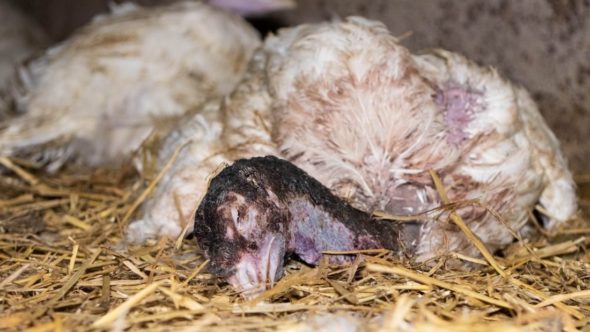
Drugs
Throughout their lives, turkeys may be given antibiotics and other drugs to prevent or treat infections caused by worms, fungi, bacteria and other microbes. More than a dozen antibiotics are approved for use in chickens and turkeys, including erythromycin, penicillin, tetracycline and virginiamycin.
Turkeys would naturally live to about 13 years of age in the wild, whereas farmed turkeys are usually slaughtered between the ages of 12 and 26 weeks.
For transportation to processing plants where the turkeys are killed and turned into featherless, plastic-wrapped meat, the birds are roughly caught and crammed into transport crates, which often results in severe bruising and injury.
The majority of poultry in the UK, including turkeys, are gassed to death. Birds remain inside their transport crates which are placed into special containers where they are killed by a mixture of air and gas. UK legislation states that they must be exposed to a deadly amount of gas – it is not legal to simply stun them.1RSPCA, 2020. Slaughter Fact File. Available at: https://www.rspca.org.uk/adviceandwelfare/farm/slaughter/factfile [Accessed 22 April 2020]
The other main slaughter method is throat cutting preceded by electrical stunning. Live turkeys are hung up by their legs in metal shackles and are moved along an overhead conveyor system. They are stunned in an electric water bath after which they move on to a mechanical neck cutter, which cuts the major blood vessels in the neck. As some animals lift their necks to avoid the stun bath and mechanical neck cutter many, many are still alive when they’re dipped in boiling water to loosen their feathers and are essentially boiled alive. Shackling the birds and hanging them upside down by their leg causes pain and major stress.1RSPCA, 2020. Slaughter Fact File. Available at: https://www.rspca.org.uk/adviceandwelfare/farm/slaughter/factfile [Accessed 22 April 2020]
For purposes of religious slaughter, turkeys have their throats cut by hand without pre-stunning and it can take them up to two minutes to die.2Defra, 2015. Halal and kosher slaughter. Available at: https://www.gov.uk/guidance/halal-and-kosher-slaughter [Accessed 22 April 2020]. A long painful death.
Turkey Industry
Turkey meat production decreased by 19 per cent (34 thousand tonnes) between 2015 and 2017, which is the lowest it has been since 2009. In 2018, the production increased by 6.6 per cent.
In 2020, 14 million turkeys were slaughtered, producing 143,000 tonnes of turkey meat.3https://assets.publishing.service.gov.uk/government/uploads/system/uploads/attachment_data/file/1034693/AUK-2020-19nov21.pdf [Accessed 22 April 2020].
In 2014, 14.8 percent of all poultry meat eaten across the EU was from turkeys. Turkey production in the EU is concentrated in just a few Member States. Germany, France, Spain, Italy, UK and Poland, who together produce more than 93 per cent of all EU turkey meat (1.9 million tonnes).4Marquer, P., Rabade, T., Forti, R., 2015. Meat production statistics. Eurostat. Available at https://ec.europa.eu/eurostat/statistics-explained/pdfscache/28947.pdf [Accessed 22 April 2020].
UK turkey meat market
The UK has seven main players in turkey production for the Christmas market:
- Bernard Matthews (24%),
- Avara Foods (22%),
- Independent turkey farmers (18%),
- Grove (14%),
- Gressingham Foods (14%),
- Traditional Norfolk Poultry (4%)
- and, Capestone (4%)5Ryan, C., 2019. ‘Talking Turkey’. Poultrynews.co.uk Poultry News. Available at: http://www.poultrynews.co.uk/production/turkeys/talking-turkey.html [Accessed 22 April 2020].
Turkeys Deserve Love
Suggested caption: Turkeys are loving animals who form close social bonds with those around them. Animal farming denies them this natural instinct as they are forced to live in overcrowded, filthy conditions where their unable to show the natural behaviours. Show turkeys the same love we show other animals by choosing vegan!
Turkeys Are So Much More Than Your Christmas Dinner
Suggested caption: Most people only think of turkeys when they think of Christmas Dinner, but these intelligent and loving birds are so much more than this. They form complex social bonds and can even solve puzzles, according to scientists. Leave turkeys off your plate this Christmas!

